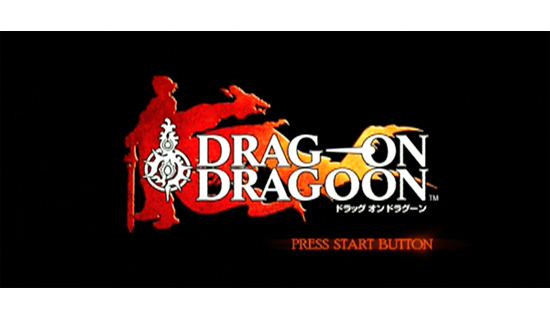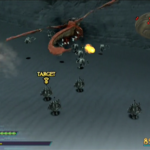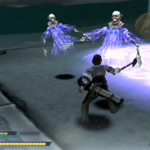A few months into the merger between Square and Enix, Square had not yet begun to fall out of the good graces of many of its loyal fans. While they weren’t the highly experimental Square of the 1990s, their catalog hardly consisted only of releases from flagship series Final Fantasy and Dragon Quest. Traditional JRPGs still reigned, but Square Enix had some notable action RPGs in their back catalog: Parasite Eve, Vagrant Story, and the Seiken Densetsu/Mana series (of which a remake of the first entry in the franchise had just released on the Game Boy Advance). 2003 would also see a new series added to that list: Drag-On Dragoon/Drakengard.
Drag-On Dragoon was developed by the Tokyo-based (and now disbanded) Cavia. They were a very young studio, and while this was not Cavia’s first RPG (that honor belonged to a One Piece licensed game on the Game Boy Advance, “nanatsu shima no daihihou”), it was their first action game of any kind. So why would Square Enix publish a new action RPG property when they had plenty of other franchises they could pull from? This was meant from the start to be a dark RPG, unlike most of Square Enix’s other properties. The story was written by Yoko Taro (who was also the game’s director) and Natori Sawako, and is easily the highlight here despite being presented in a fairly bland manner for large chunks of time. The game’s Japanese slogan was “抗え、最後まで” or “Resist until the very end”.
Long ago, when dragons still flew the skies, a war erupted that split the world in two. Many battles unfolded between the two sides: The Union (those who have faith in the Goddess, protector of the seals that preserve the world’s balance) and the Empire (those who have risen to power and blindly accept the beliefs of a mysterious religious organization called the “Church of Angels” (Or “The Watchers”), who reject faith in the Goddess). The Union has been overwhelmed by The Empire, who have been able to grant their warriors a mysterious and great power through an epidemic known as Red Eye Disease.
With things looking so bleak for the Union, we enter our main character: A Union soldier named Caim (Main character “Kaim” of the 2007 XBox 360 RPG Lost Odyssey would have an oddly similar name, and it should be noted that they would be written exactly the same way in Japanese): A former Prince who has lost his parents and country to the Empire’s dragons. He’s also older brother to Furiae, the Goddess herself. Caim sustains a nearly fatal wound in battle from protecting his sister, but just before death encounters a similarly wounded red dragon named Angelus. A pact is formed between the two, and through that they are able to once again grasp hold of life and gain greater power. These pacts come with great costs to humans though, and in Caim’s case he loses his ability to speak, making the Angelus his voice when needed. Caim was also based on Guts, the main character of the popular dark fantasy manga/anime Berserk (this was even Caim’s name during early development). Furiae was based off of Rei Ayanami from Neon Genesis Evangelion. In fact Evangelion was a big inspiration for the story in general, and it’s written all over some of the endings. Taro also cites an early 2000s manga and anime called “Sister Princess” as being an influence.
 | 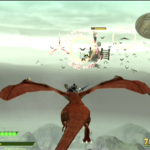 |
| Caim and Angelus making their pact | You’ll be on the edge of your seat as Caim and Angelus take on such threatening enemies as clouds of bats! |
Their dark journey to protect the remaining seals (which needless to say doesn’t end up going so well) continues on from here, involving Caim’s best friend Inuart, a Priest named Verdelet, a man who formed a pact with a faerie after losing his brothers to the Empire named Leonard, a mad Elven woman who was imprisoned by the Empire after the murder of her family named Arioch, and a boy trying to get his sister back from The Watchers named Seere. The plot unfolds in many unexpected directions, with new missions and scenes opening up in previous portions of the game after completing later parts. This structure allows for five different endings, each more complex in both requirements to unlock it and its impact on the story itself. One leads into a game that will end up being Cavia’s swan song.
A large part of what makes the story interesting is the characters, and the fact that most of them are horrible people. This starts with our hero, Caim. He slaughters thousands of Imperial troops without any remorse, and is generally a complete asshole to his companions throughout the story. While all of this is in the name of saving his sister, it quickly seems to go beyond that. Caim begins to visibly hunger for more and more Imperial genocide as the game goes on, and at points Angelus even questions just how much it will take to satisfy him. Verdelet is a pedophile who attempts to suppress his desires, though giving into them was the reason for him not being there at the time his brothers were killed. You never see him engaging in anything unsavory, and it’s just strongly hinted at as opposed to being blatantly spelled out. However knowing this makes you question his relationship with Seere. Lastly we have perhaps the most screwed up character of the bunch, Arioch. While she isn’t featured in the story as much as Verdelet, she’s clearly insane and absolutely a cannibal who prefers to eat children. She does this because she feels they’ll be safe within her (probably as a result of what happened to her own family), but that still doesn’t change that she eats them.
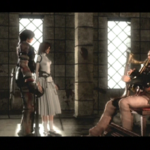 | 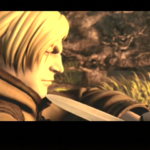 |
| Inuart as that one guy at the party who just has to pull out the harp… | Leonard trying to end his own life after the death of his brothers, but ultimately not being able to do it |
Dynasty Warriors was a clear inspiration for the combat, given that you’re always on a battlefield with mobs of soldiers. Variety is introduced through the ability to summon one of your allies into battle and briefly take control of them, as well the ability to wield many different weapons of various speeds and strengths. The weapons also have different magic abilities that can be used by filling up a meter in combat. Each weapon can also be leveled up to 4. which extends the length of the combos that can be performed. You can also take advantage of a finishing blow by performing your combo correctly. The problem is that most of the weapons available are useless, and Dynasty Warriors is just more fun and satisfying to play than this! Whereas Dynasty Warriors starts off feeling relatively easy and gets you into harder content as you move along, Drag-On Dragoon does the opposite. Dynasty Warriors experience makes you think you can mash through regular battles, but doing that will get you killed over and over again. Luckily there is also an Easy difficulty to change to, which helps mostly in that health drops from enemies seem far more frequent. The awful fixed camera (this was a PS2 game after all) doesn’t help either, and can be the cause of many deaths. Yoko Taro even later expressed his extreme dislike for the camera in an interview.
Ground battles are spiced by giving you the ability to ride on Angelus, changing up the dynamic significantly. But before you think that this will balance out the mundane ground battles, strafing back and forth across a battlefield and breathing fire down at troops also gets old very quickly. Not to mention that arbalists are your worst enemy while riding the dragon, and there will nearly always be plenty of them to knock you off after only a few hits. The aerial dragon riding levels are this game’s unique feature. It actually started development only with these portions, since the team had a developer that used to work on Namco’s Ace Combat series at that time (they claim no influence from Panzer Dragoon, even though well…it’s a flying dragon). While these levels do a great job of breaking up the monotony of the ground battles at first, they too become monotonous with the similarly bland environments and uninspired enemies. They still ended up being my favorite parts of the game though.
Free Expedition mode also features various scenarios that unlock in it as you progress through the story, and is a mode meant to allow you to level your character without things like timers and changing mission objectives getting in the way. You can also go back to previous story missions at any time to do the same thing. Often the story missions will be a more sensible way to go about leveling, since the scenarios in the Free Expedition mode can be fairly challenging.
Drag-On Dragoon’s cut-scenes do look very nice, and they are clearly where the bulk of the budget went. The rest of the game is pretty uninspired and bland looking though, with draw distances that are laughable for the PlayStation 2’s hardware. The sound track is incredibly plodding, making for an appropriate companion to the equally plodding game play. It’s been stated in interviews that the soundtrack wasn’t written to be particularly commercially appealing, but rather to be something more experimental. It was also said that it was meant to emulate the feel of the game play, with feelings of madness and despair heightening as the game progressed. The voice acting in both the Japanese and English versions of the game is also lacking any sort of real depth for the most part, falling solidly into being just average.
In fact that really is what this game is: average. The rest of the game just wasn’t able to support the narrative, and probably should have tried some unique and trippy things to match its tone. Even drastically shortening many of the missions or making the combat less of a direct Dynasty Warriors copy could have gone a long way toward balancing things out. Those interested in seeing how the series began are probably better off reading the many takes and interpretations of the plot that are out there, or watching a compilations of all of the cut-scenes.
